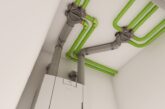
Charlie Ayers, the founder of SureCav, talks about the importance of properly constructed cavities.
The introduction of the Domestic Minimum Energy Efficiency Standard (MEES) in 2018 means all new builds must adhere to a minimum-level of energy efficiency. A positive move from the UK government, it has led to a substantial cut in carbon emissions from home energy use and significantly slashed homeowners’ electricity bills.
Currently the housebuilding, and wider construction, sector is one of the biggest polluters, responsible for around 40 per cent of the global carbon footprint. For the most part, this can be attributed to operational emissions; in other words, the energy needed to heat, cool and light a building. As such, initiatives such as the MEES are imperative in the fight against climate change.
Furthermore, they are essential if we are going to come anywhere near meeting our 2050 net-zero carbon targets, so it’s important we all adhere to this standard and aim to meet its criteria.
Hazards of poor insulation installation
One of the most popular, simple and effective methods which allows builders to meet the MEES is the installation of efficient wall insulation, keeping warm air trapped within a house and reducing the need for excessive use of central heating. All houses use cavity wall insulation, the layer of insulation will keep the U-value of the wall low, lowering the transmission rate of heat energy and the risk of thermal bridging.
Unfortunately, poorly installed insulation can allow water from the outside in and be contaminated by mortar, increasing moisture levels inside. This issue is compounded as warm air traps moisture, leading to the formation of damp. Worse, this build-up of moisture inevitably results in mould and mildew on walls, windows and the loft space. That’s just what you can see. Beyond the building itself, mould can negatively affect occupant health.
In areas with adverse weather conditions, the moisture problem is further exacerbated as wind driven rain can easily penetrate the outer wall, leading to more water being trapped within the cavity.
Prolonged exposure can cause ailments such as asthma and other respiratory illnesses. Those who already suffer from asthma or allergies can have even more severe symptoms. The World Health Organisation links a significant proportion of childhood asthma cases to indoor dampness and mould. However, it’s possible to install an effective cavity barrier that will keep moisture to a minimum while helping achieve the low U-values required by the MEES.
Moisture in the wall cavity also presents big structural problems. Damage readily occurs not just to the insulation but also wall ties, affecting wall plates, the frame itself and any installed joinery. Ultimately, every part of the building envelope is susceptible.
![]()
The solution
New innovations in building materials mean that backing blocks can be replaced by a non-porous, polypropylene sheet that maintains an effective air gap, an essential element in cavity wall construction. This seals the wall against wind-driven rain and other outside moisture, keeping the insulation within dry and preventing the formation of damp and mould. The sheet itself allows a thicker layer of insulation to be used in the cavity, delivering a lower U-value and improved energy efficiency.
An added bonus of using polypropylene sheets is they also help reduce embodied carbon, just like improved insulation. Using these sheets removes a layer of concrete within the wall.
Concrete is one of the most carbon intensive materials in the construction sector. As such, designing it out is vital to help keep the industry’s carbon footprint as low as possible.
In today’s eco-aware society, it’s crucial we push for more sustainable construction practices. Reducing operational emissions of buildings through a focus on energy efficiency is an excellent approach to this issue. However, it’s equally important housebuilders do not rush insulation installation as it will have a significant impact on the health of the building and its occupants.
Fortunately, choosing between energy efficiency and occupant health needn’t be a zero-sum game. We implore everyone in the industry to take the time to research what products are available that will achieve both strong U-values and protect residents from damp.







